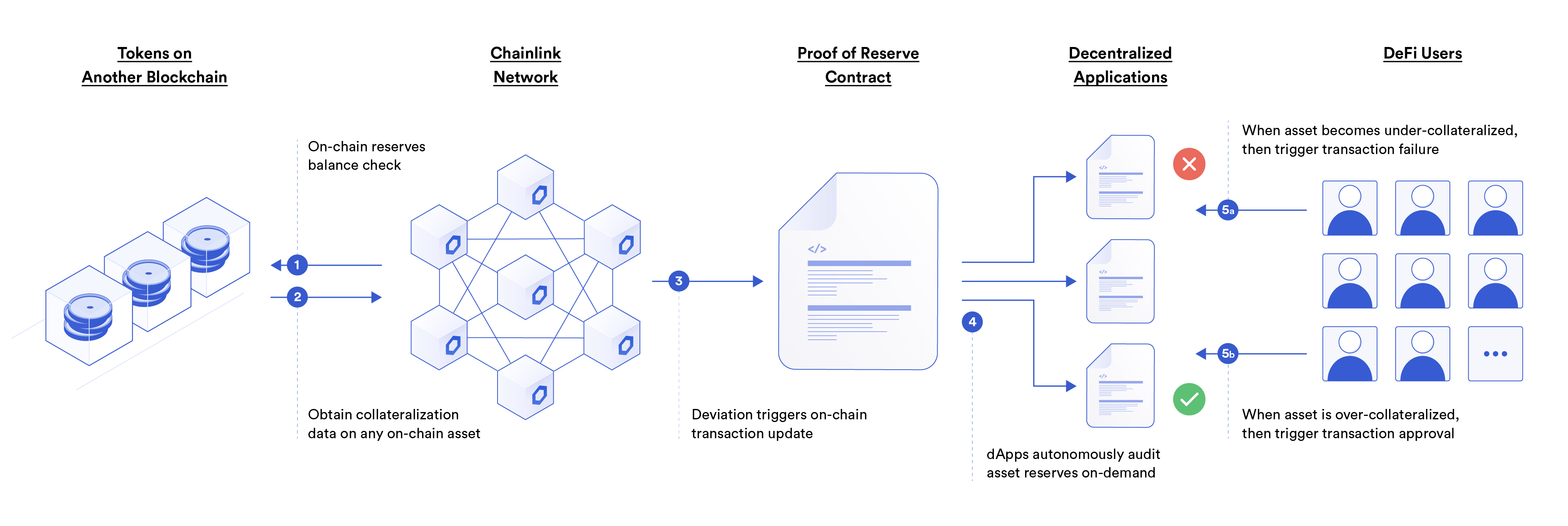SmartData
Chainlink SmartData is a suite of onchain data offerings designed to unlock the utility, accessibility, and reliability of tokenized real-world assets (RWAs). By providing secure minting assurances alongside essential real-world data such as reserves, Net Asset Value (NAV), and Assets Under Management (AUM) data, the SmartData suite embeds security and enriches data into tokenized RWA offerings.
You can read these feeds the same way that you read other Data Feeds. Specify the SmartData feed address that you want to read instead of specifying a price feed address. See the Using Data Feeds page to learn more.
SmartData Product Types
Proof of Reserve Feeds
Proof of Reserves feeds provide the status of reserves for stablecoins, wrapped assets, and real world assets. Proof of Reserve Feeds operate similarly to Price Feeds, but provide answers in units of measurement such as ounces (oz) or number of tokens.
To find a list of available Proof of Reserve Feeds, see the SmartData Feed Addresses page.
Types of Proof of Reserve Feeds
Reserves are available for both cross-chain assets and offchain assets. This categorization describes the data reporting variations of Proof of Reserve feeds and helps highlight some of the inherent market risks surrounding the data quality of these feeds.
Reserves are available for both offchain assets and cross-chain assets. Token issuers prove the reserves for their assets through several different methods.
Offchain reserves
Offchain reserves are sourced from APIs through an external adapter.

Offchain reserves provide their data using the following methods:
- Third-party: An auditor, accounting firm, or other third party audits and verifies reserves. This is done by combining both fiat and investment assets into a numeric value that is reported against the token.
- Custodian: Reserves data are pulled directly from the bank or custodian. The custodian has direct access to the bank or vault holding the assets. Generally, this works when the underlying asset pulled requires no additional valuation and is simply reported onchain.
- ⚠️ Self-reported: Reserve data is read from an API that the token issuer hosts. Reserve data reported by an asset issuer's self-hosted API carries additional risks. Chainlink Labs is not responsible for the accuracy of self-reported reserves data. Users must do their own risk assessment for asset issuer risk.
Cross-chain reserves
Cross-chain reserves are sourced from the network where the reserves are held. Chainlink node operators can report cross-chain reserves by running an external adapter and querying the source-chain client directly. In some instances, the reserves are composed of a dynamic list of IDs or addresses using a composite adapter.

Cross-chain reserves provide their data using the following methods:
- Wallet address manager: The project uses the IPoRAddressList wallet address manager contract and self-reports which addresses they own. Reserve data reported by an asset issuer's self-reported addresses carries additional risks. Chainlink Labs is not responsible for the accuracy of self-reported reserves data. Users must do their own risk assessment for asset issuer risk.
- Wallet address: The project reports which addresses they own through a self-hosted API. Reserve data reported by an asset issuer's self-reported addresses carries additional risks. Chainlink Labs is not responsible for the accuracy of self-reported reserves data. Users must do their own risk assessment for asset issuer risk.
NAVLink Feeds
Chainlink NAVLink Feeds provide real-time, tamper-proof data on the Net Asset Value (NAV) of tokenized assets, funds, or portfolios. NAV is an essential metric in the financial industry for assessing the value of mutual funds, ETFs, and other investment vehicles. It is calculated by subtracting total liabilities from the total assets held within the vehicle.
By making NAV data available onchain, developers can build decentralized applications that require accurate and up-to-date valuation metrics. These applications include asset management platforms, DeFi protocols, and investment strategies that rely on NAV for operations such as rebalancing, minting, or redemption.
To find a list of available SmartNav Feeds, see the SmartData Feed Addresses page.
SmartAUM Feeds
Chainlink SmartAUM Feeds provide current data on the total market value of assets managed by an entity on behalf of clients. Assets Under Management (AUM) is a crucial indicator used in financial analyses and decision-making processes.
By bringing AUM data onchain, decentralized applications can access information for activities such as risk assessment, performance benchmarking, and investment strategy development.
To find a list of available Assets Under Management Feeds, see the SmartData Feed Addresses page.
Using SmartData
Read answers from SmartData feeds the same way that you read other Data Feeds. Specify the SmartData feed address that you want to read instead of specifying a Price feed address. See the Using Data Feeds page to learn more.
Using Solidity, your smart contract should reference AggregatorV3Interface, which defines the external functions implemented by Data Feeds.
Example for reading a Proof of Reserve feed:
// SPDX-License-Identifier: MIT
pragma solidity ^0.8.7;
import {AggregatorV3Interface} from "@chainlink/contracts/src/v0.8/shared/interfaces/AggregatorV3Interface.sol";
contract ReserveConsumerV3 {
AggregatorV3Interface internal reserveFeed;
/**
* Network: Ethereum Mainnet
* Aggregator: WBTC PoR
* Address: 0xa81FE04086865e63E12dD3776978E49DEEa2ea4e
*/
constructor() {
reserveFeed = AggregatorV3Interface(
0xa81FE04086865e63E12dD3776978E49DEEa2ea4e
);
}
/**
* Returns the latest price
*/
function getLatestReserve() public view returns (int) {
// prettier-ignore
(
/*uint80 roundID*/,
int reserve,
/*uint startedAt*/,
/*uint timeStamp*/,
/*uint80 answeredInRound*/
) = reserveFeed.latestRoundData();
return reserve;
}
}